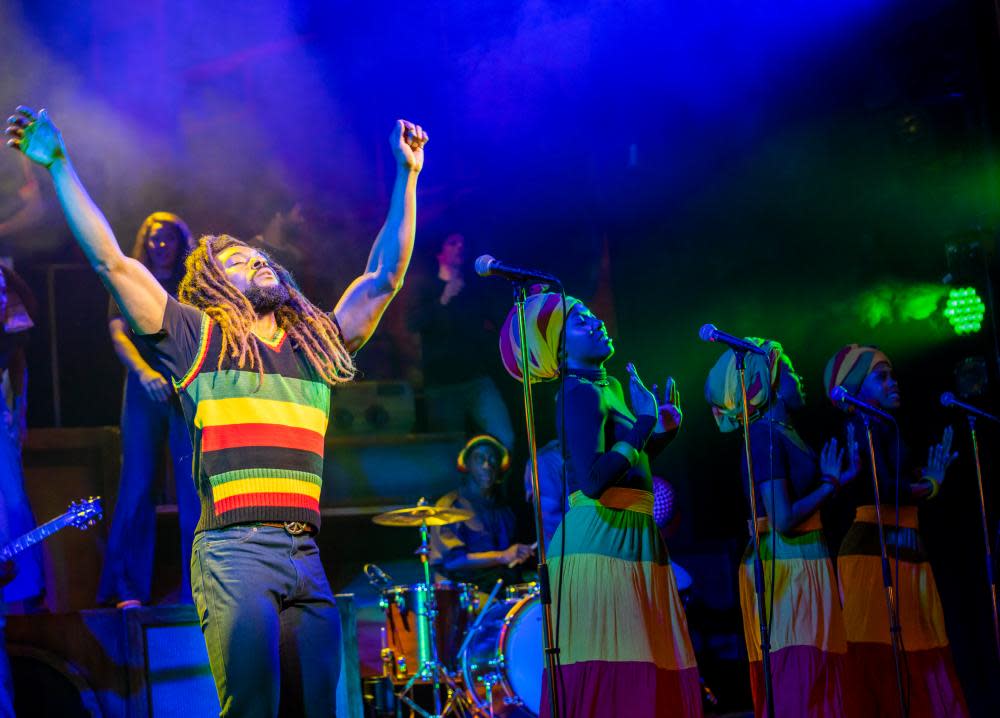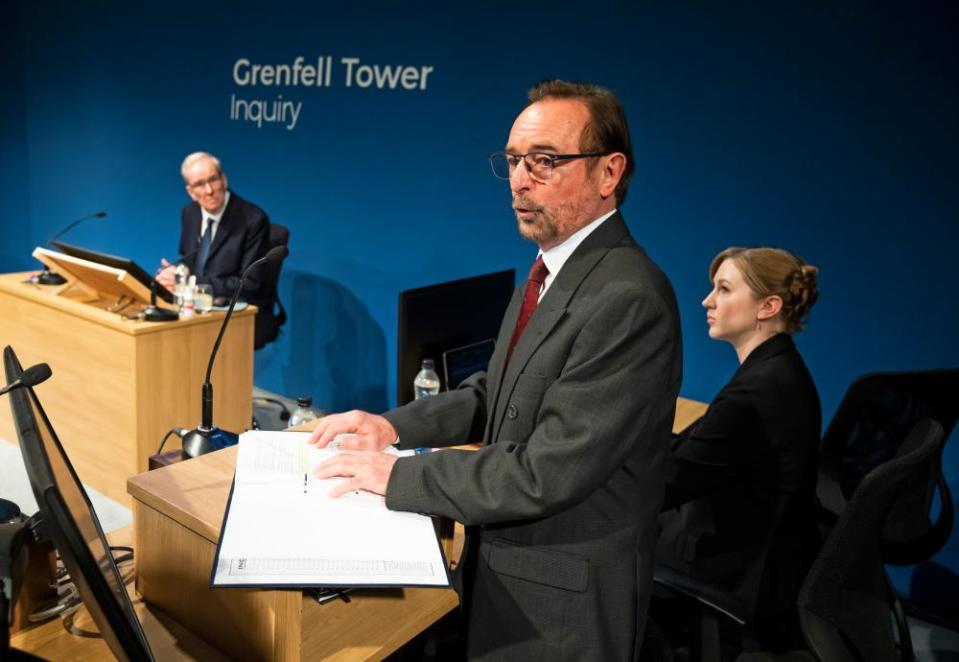The week in theatre: Get Up, Stand Up!; Value Engineering: Scenes from the Grenfell Inquiry; Love and Other Acts of Violence

Get Up, Stand Up! could hardly fail to ignite, what with the flair of the music and the flare of the subject matter. Live on stage are some of the most glorious, ear-changing numbers of the past 60 years: Is This Love, I Shot the Sheriff, Redemption Song. The titles wire you into the incendiary short life of Bob Marley, dead of cancer in his 30s. Arinzé Kene – who triumphed as an actor in Girl from the North Country and One Night in Miami and as a playwright with Misty – expands his repertoire of success. As Marley he is both rousing and easily loping. He can seem to touch the sides of the stage with his outstretched arms as he hits the roof with his ringing notes.
Yet this jukebox musical, directed by Clint Dyer, who is first generation British Jamaican, and written by Billy Elliot dramatist Lee Hall, who is white British, sputters rather than flames. It is roughly framed as a concert, beginning with a warmup act who plays an Island Records precursor to Marley and reggae – My Boy Lollipop – and observes that Jamaican patois is no more difficult to follow than Shakespeare. Charles Balfour’s murky lighting is concert-like, as is Chloe Lamford’s design of heaped-up sound systems. You know you have moved from Kingston to England only because it’s snowing and a black cab won’t stop for a black man.
The aim is quick impressions, but what should be fleet is skimpy. Tiny scenes of big events – gang shooting, parental abandonment, falling in love, becoming politicised – flick on and off without any sense of danger or of being driven. Black Lives Matter footage seems unearned. The music survives but the significance is diminished.
Some trouble has been taken to give a good shout to the women around Marley: they all sing fit to part the Red Sea, and made me long to see them centre stage; never has the sight of three marvellous backing singers in a glass box seemed so telling. As Marley’s wife, Rita, Gabrielle Brooks, who soared in Twelfth Night and J’Ouvert, is the other knockout. West End audiences always seem to love a woman belting defiantly when earlier she has been given a slap, and Brooks’s No Woman, No Cry gets one of the roars of the evening. But she is worth a roar throughout. A lioness of Judah.
Value Engineering is a much-needed play. Spoken statements given under oath to the Grenfell inquiry have been edited by Richard Norton-Taylor with Nicolas Kent, who also directs. The resulting scenes, four years in the making, are further evidence of the institutional disregard for citizens who are not rich and not white. They are also a reminder of principles that have gone missing in the bilgey rhetoric of recent public life. Insistence on truth. Insistence on careful scrutiny of the facts. Clear logical thinking. Close examination of accepted systems. Disregard of entitlement. The assumption of an intelligent public.
At the Tabernacle in west London, a 15-minute walk from Grenfell Tower, witnesses and their examiners sit at plain wooden desks in unsparing steady bright light. As chairman and counsel to the inquiry, Thomas Wheatley and Ron Cook are on stage throughout: scarcely moving, focused, beady. Behind them a screen displays emails sent by witnesses, plans of the building and – briefly – footage of the fire, streaking up the tower: as if, a firefighter says, “someone had poured petrol down one side of the building”. The detail is technical, unstinting. The catalogue of neglect and refusal to take responsibility mounts every minute.

The architect who thought it “too onerous” to check compliance with building regulations, agreeing under questioning that he regarded his job as primarily aesthetic – whatever happened to design as function-led? The consultant to the fire safety advisers who tells the architect “we can massage the proposal to something acceptable”. The specialist cladding contractor who did not know of the history of fires on cladding on high-rise residential buildings and who also found the building regs “quite complicated”. The borough surveyor who failed to notice that cavity barriers around the windows, which would have prevented internal fire spreading to the cladding, were missing, and who, though knowing the composition of the cladding had changed, did not know anything about polyethylene, a main combustible component.
“Value engineering” – the attempt to achieve a result with maximum savings – goes to the heart of the matter. At Grenfell, it meant cost-cutting with little regard for safety. There was crooked practice, which included trousering of some of the “economies”. There was feeble-minded sloppiness – an innate disdain for professional skill. And there was lack of imagination of any human consequences. Kent’s production is exact, clinical; it requires us to attend not to personalities but to systemic failure, to listen for the truth rather than the excitement of drama. It does, though, supply one glimpse of the experienced horror of 14 June 2017. One firefighter took it upon himself to try to save a boy who had been calling for help on a high floor. He found lift doors opening on smoke; he heard a strange fizzing sound from outside; he could not reach the boy.
The Donmar has reopened, redesigned by Haworth Tompkins, less comprehensively than originally intended – Covid curtailed the plans – but with new space and more loos, improved ventilation, and with the bar spun round, opened up, tempting you in rather than as before squeezing you out. H-T buildings are like a good plot: they keep moving you on, pushing you from street to stage, barely realising you are being persuaded. A mural by Tom Scutt – scarlet, pink and black, curling around a circular pillar, runs like a bolt through the building: like the Donmar itself, it is festive and industrial.
The season – which will include Max Webster’s update of Henry V and a play by Jackie Sibblies Drury about Mary Seacole – opens with a specially commissioned work from Cordelia Lynn, author of Lela & Co and of versions of Three Sisters and Hedda Gabler (called Hedda Tesman). Love and Other Acts of Violence is a rum affair. It opens quiveringly, with young partygoers Tom Mothersdale and Abigail Weinstock on Basia Bińkowska’s stripped-to-the-elements grit and wood design. Mothersdale, as Him, twitches with self-importance, physical desire and political zeal, using his intricate magnified gestures to convey half-concealed threat; he is tortured, his wrists twist backwards; he is predatory, looming so far over Weinstock (Her) that she is obliged to perform a backbend. In her stage debut, Weinstock is beautifully still, withheld, intriguing. They get together. He rages against capitalism; she has anguished soliloquies; their love affair becomes emotionally, verbally and physically violent as the world around them becomes increasingly repressive.
They are not altogether plausible as a couple, but they are interestingly tense. Are they doomed to fail? Lynn finds the answer in a version of inheritance that I find hard to credit. The play jumps violently: to 1918, to Lviv, in the western Ukraine and to a detailed naturalism; Bińkowska creates an intricately wrought wooden sitting room. Here – in the Lviv pogrom – horror occurs. Here, Lynn seems to be saying, are the origins of her modern couple’s strife: in ancestral violence. I admire the boldness of her leaps; I didn’t believe in the psychology. Easier in the theatre – and in life – to convince me with the power of memory than with an idea of blood inheritance.
Star ratings (out of five)
Get Up, Stand Up! ★★★
Value Engineering: Scenes from the Grenfell Inquiry ★★★★
Love and Other Acts of Violence ★★★
Get Up, Stand Up! The Bob Marley Musical is booking at the Lyric, London, until 3 April 2022
Value Engineering: Scenes from the Grenfell Inquiry is at the Tabernacle, London, until 13 November
Love and Other Acts of Violence is at the Donmar Warehouse, London, until 27 November


